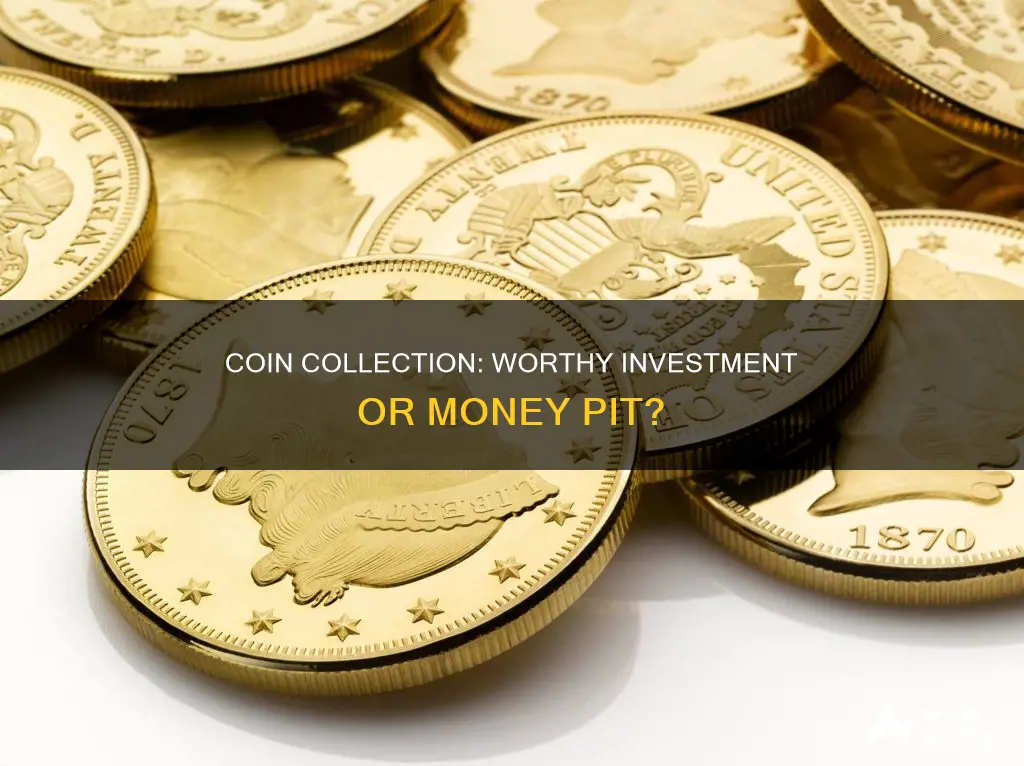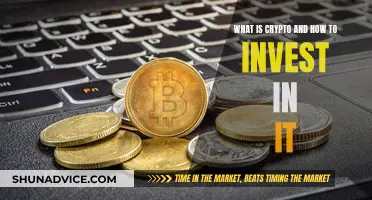
Coin collecting is a popular hobby for many, but is it a good investment? Coins are considered a tangible asset, and like any other investment, there are risks involved. The value of a coin is determined by its bullion value and its numismatic value. The bullion value is calculated based on the quantity of precious metal in the coin, usually gold, silver, palladium or platinum, and the spot price per ounce of the metal. The numismatic value is based on the rarity of the coin and the sentiment of the owner and is harder to determine.
Coins can be a good investment if you are willing to wait for a return and pay attention to pricing trends. They can be a great way to diversify your portfolio, protect against inflation, and gain exposure to precious metals. However, there are some drawbacks to investing in coins, such as the high bid-ask spread, which can make them inefficient for trading. It's important to do your research, understand the market, and be aware of the risks before investing in coins.
| Characteristics | Values |
|---|---|
| Investment type | Bullion or numismatic |
| Investment purpose | Profit generation |
| Investment focus | Monetary growth, precious metals |
| Investment horizon | Long-term or short-term |
| Buying behaviour | Opportunistic |
| Collector purpose | Enjoyment, passion, history |
| Collector focus | Series, country, theme, history |
| Collector behaviour | Emotional, patient |
| Common ground | Grading, basics of the coin industry |
What You'll Learn

Coins as bullion vs numismatics
Coins as bullion and coins as numismatics are two distinct types of coin investments. Bullion coins are valued primarily for their metal content, while numismatic coins are valued for their rarity, historical significance, and collector appeal.
Bullion coins are typically purchased as an investment, inflation hedge, or survival strategy. The value of a bullion coin is based on the weight and spot price of the precious metal it contains, such as gold or silver. Examples of bullion coins include Canadian Gold Maples, South African Krugerrands, and American Gold and Silver Eagles. Bullion coins are a good option for investors looking purely at the investment potential of precious metals.
On the other hand, numismatic coins are considered collectibles and are valued differently from bullion coins. The value of a numismatic coin is influenced by factors such as rarity, condition, historical significance, and production location, in addition to the precious metal content. Numismatic coins are often older, rare coins that are sought after by collectors. For example, a 1907 $20 St. Gaudens, High Relief Double Eagle gold coin can be worth 500 times the spot price of gold due to its rarity and historical value.
While bullion coins are typically purchased as an investment strategy, numismatic coins are often collected as a hobby or for their historical value. Numismatic coins can be a profitable investment, but they are subject to different market forces than bullion coins. The numismatic coin market is less liquid and more dependent on factors such as collector demand, rarity, and auctioning. Therefore, extensive research and knowledge of the rare coin market are necessary when investing in numismatic coins.
In summary, bullion coins are valued primarily for their metal content and are suitable for investors seeking precious metal investments, while numismatic coins are valued for their rarity, historical significance, and collector appeal, attracting those interested in coin collecting as a hobby or passion.
How to Invest in Dogecoin Using Fidelity
You may want to see also

Coins as a hedge against inflation
Coins have long been considered a good investment option, with some sources even calling it a "profitable venture". The value of coins comes from two main sources: the physical metal they contain (bullion value) and their collector or numismatic value.
Bullion value refers to the intrinsic value of the metal the coin is made from, such as gold or silver. The value of a coin can be calculated by multiplying the number of ounces of metal in the coin by the spot price per ounce of that metal.
Numismatic value, on the other hand, is based on the rarity of the coin and the sentiment of its owner. This type of value is harder to determine and is often applied to antique and rare coins. The condition of the coin also plays a role in its numismatic value, with uncirculated coins generally being worth more.
Collecting coins can be a hedge against inflation as they are considered a tangible asset that can diversify an investment portfolio. Coins, especially those made from precious metals, are likely to gain value over time due to their limited supply and increasing demand. This makes them a good store of value during times of economic uncertainty and inflation.
Gold coins, in particular, have been used as a hedge against inflation due to their positive price elasticity. As demand for gold increases, so does its value, even if the Fed rate is lowered or raised. Gold also has a long history of maintaining or improving its value over time, making it a reliable store of wealth.
However, it is important to note that investing in coins, especially rare coins, can be risky. The market for rare coins can be volatile and fluctuate with precious metals pricing. Therefore, it may not be the best investment option for those seeking short-term profits. Additionally, the numismatic value of coins can be subjective and depend on buyer sentiment, making it difficult to predict future values.
Overall, coin collecting can be a fun and profitable hobby, but it is important to do your research and understand the risks involved before investing.
The Future of Bitcoin: Predicting Your Investment's Worth
You may want to see also

Coins as a tangible asset
Coins are a tangible asset that can be a good investment for several reasons. Firstly, they offer protection against inflation. As inflation causes the value of currency to decrease, investing in physical coins can help maintain the value of your money. Secondly, coins have intrinsic value due to their physical properties. The raw materials that make up coins, such as gold and silver, have market value as they can be converted into other goods or used in manufacturing. This intrinsic value makes coins a valuable and desirable asset. Thirdly, coins are a great way to diversify your investment portfolio, especially during uncertain economic times. They are uncorrelated to traditional investments like stocks and bonds, so adding coins to your portfolio can reduce overall risk.
Coins also have numismatic value, which is influenced by their rarity, condition, and collector demand. Antique and rare coins with low minting numbers tend to have higher numismatic value. The condition of the coin is crucial, as those closest to an uncirculated condition can fetch much higher prices. Additionally, the story and historical events behind a coin can increase its appeal and value.
While investing in coins can be rewarding, it is important to remember that there are risks involved, just like with any other investment. The value of coins can fluctuate, and the market for rare coins can be unpredictable. It is crucial to have a good understanding of pricing trends and the factors that influence coin values.
Overall, coins as a tangible asset can be a good investment, offering protection against inflation, intrinsic value, and portfolio diversification. However, it is important to do your research and understand the risks involved before investing.
Small Bitcoin Investments: Are They Worthwhile?
You may want to see also

Coins as a long-term investment
Coin collecting is a fun hobby for many people, but it can also be a profitable investment strategy. The value of a coin comes from two main sources: the physical metal it contains and its collector or numismatic value.
Bullion Value
Bullion value refers to the worth of the physical metal in a coin, usually gold, silver, palladium, or platinum. This value can be calculated by multiplying the number of ounces of metal in a coin by the current price per ounce of that metal. For example, gold and silver coins made by the United States Mint. Bullion coins are typically bought by investors for diversification and protection against inflation.
Numismatic Value
The numismatic value of a coin is based on its rarity, condition, and collector demand. Antique and rare coins tend to have higher numismatic values, especially if there were fewer examples minted. The sentiment of the coin owner also plays a role in this subjective valuation. Uncirculated coins in near-perfect condition are highly sought after by collectors and can command higher prices.
Tips for Investing in Coins
- Storage: Decide whether to store your coins at home, in a bank safety deposit box, or with a third-party storage facility. Consider factors such as accessibility, fireproof and waterproof storage, and insurance.
- Cost Management: Be mindful of the costs associated with coin investing, such as storage and management fees, insurance, and administrative charges, which can reach up to 15% of your investment.
- Long-Term Holding: Coin investing is typically a long-term, buy-and-hold strategy due to the illiquid nature of physical coins. Be prepared to hold your coins for years to allow their value to increase.
Popular Coins for Investment
Some of the most popular types of coins for investment include:
- Gold Coins: Gold coins are a preferred choice for investors due to their popularity, portability, and historical use as a safe-haven asset.
- Silver Coins: Silver is a more affordable option than gold, offering similar benefits. Silver coins have been used as a medium of exchange in the past and are in demand during high inflation periods.
- Platinum Coins: Platinum coins are gaining popularity due to their rarity, high demand in various industries, and their ability to diversify gold and silver investments.
In conclusion, coin collecting can be a rewarding hobby and a sound long-term investment strategy. By understanding the bullion and numismatic values of coins, conducting thorough research, and following wise investment practices, you can build a valuable collection that appreciates over time.
The Bitcoin Investment Trust: A Short-Term Focus
You may want to see also

Coins as a hobby
Coin collecting is a hobby that can be both rewarding and educational. It is a fun and exciting way to view different pieces of numismatic art and engage with history. The thrill of the hunt for hard-to-get coins is part of the appeal, and collectors take pleasure in completing sets and trading with fellow enthusiasts.
Collectors often focus on a particular theme, such as a specific time period, country, or type of coin, like those featuring animals or vehicles. The seemingly endless variety of coins means the possibilities for a collection's focus are nearly endless.
Coin collecting can also be an investment, with the potential for financial returns. The value of a coin is determined by its bullion value (the quantity of precious metal it contains) and its numismatic or collector value, which is based on rarity, condition, and buyer sentiment.
Coins are a tangible asset that can hedge against inflation and add diversity to an investment portfolio. They are also a great way to own a piece of history, and their small size makes them easy to store.
For beginners, it is recommended to start with bullion coins, such as modern gold or silver coins, as they have high-grade precious metals content and are also attractive. Older coins can also be good investments, such as pre-1965 American quarters and dimes, which contain 90% silver.
For those interested in the numismatic aspect, it is important to focus on coins that are likely to be in high demand among collectors, such as those with rare dates and mint marks, or rare minting errors. Certified coins, which have been inspected and graded by a recognized organization, are also recommended for numismatic investors.
Coin collecting can be a profitable venture when approached with knowledge and a bit of strategy. However, it is important to remember that, as with any investment, there are inherent risks and no guarantees.
Smart Strategies for Bitcoin Investment: How Much to Invest?
You may want to see also







